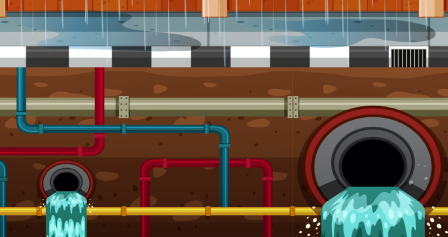PIPING GUILDELINES
Why use plastic pipe systems?
Why use plastic pipe systems?
Plastic was invented to make human life better and there are definitely some advantages of plastic pipes that have changed the world as we know it.
Plastic pipe systems have a range of service requirements that they can fulfill. The European Product standards correctly define the requirements for each application along with their specific characteristics.
Some Examples:
Hygienic requirements – conveyance of drinking water
Safety requirements – conveyance of gas
Temperature resistance over decades – plastic pipes for radiating heating and floor heating
High Chemical resistance – sewer applications
The benefits of plastic pipes are many, including the ability to perfectly fulfill the specific requirement, with high levels of performance over a long period of time. A couple of factors that are crucial for the performance of the pipes over a long period of time are reliability and safety.
The advantages of using plastic pipes can be categorized into mainly three reasons:
Flexibility
Plastic pipes are classified by their ring stiffness. The ring stiffnessis important if they are needed to withstand external load and pressure during installation. The flexible nature of pipes ensures that they would survive the pressure and not break. The deflection can take place while keeping up with its original function.
Long Life
For a century, plastic pipes have served us successfully. The predicted lifespan of a plastic pipe is more than a 100 years! Plastic pipes have always been classified on the basis oflong-term pressure testing.
Safety Factor
The use of plastic pipes also takes into account, the safety factor. The qualified nominal pressure of a plastic pipe has always included a safety factor and it helps in designing of the piping system.
Fast Guide to Materials
Various types of materials are used in plastic piping systems. We have a wide range of products to work with and their properties make plastic pipes the ideal choice for anything, from pressurized water mains to gravity sewer systems and indoor heating systems.
The four main types of plastic pipes we produce: PVC, HDPE, MDPE and PPRC, SWV and Electrical Conduits. A variety of pipe systems have these materials. Industrial pipe systems are mainly found in ABS.

PVC – The widely used material
Polyvinyl Chloride or PVC is a thermoplastic material derived from common salt and fossil fuels. The first PVC pipes dates back to 1930s. In the 1950s, these were used to bring in fresh drinking water to the growing urban population. This material has made a significant contribution to public health, hygiene and well-being.
PE – A wide variety of applications
Derived from fossil fuels, Polyethylene or PE is a tough thermoplastic material. It is used for a broad range of pressure applications which include transportation of drinking water and natural gas, irrigation, sewers, and drainage lines.


PPRC – Most versatile polymer
Made from polypropylene, PP is a thermoplastic polymer. Though invented in the 1950s, it has been used only since 1970s. The high impact resistance, with good stiffness and excellent chemical resistance, make this material suitable for sewer applications. This material is used for in-house discharge systems for soil and waste when it’s continuous, and also for warm water supply when it’s short-term.
Buried Pipes Design
In the buried pipes design, five objectives have been defined:
- Several data sets to become available for validating current and future design methods
- One clear design and installation advice to customers
- Avoid overkill in installation requirements
- Design to be in balance with feasible installation methods
- Increase the confidence in thermoplastics pipes for buried application in the marketplace

